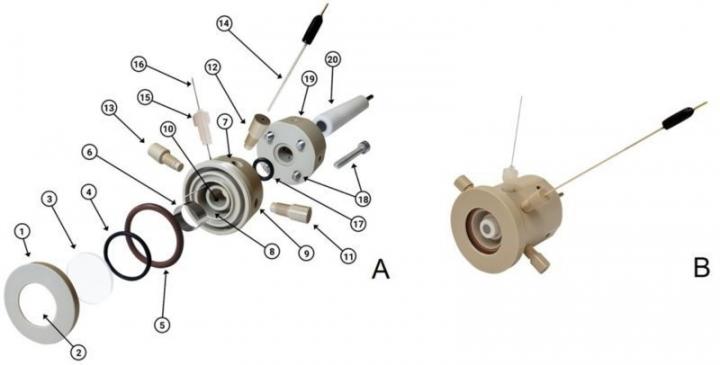Developed at an Engineering Research Center supported by FAPESP, the novel spectroelectrochemical cell can be used to study the behavior of electrolytes and catalysts by means of X-rays and infrared or even visible light

Credit: Researcher’s archive
A new device designed to help scientists study in detail what happens during electrochemical reactions has been developed by researchers at the Center for Innovation in New Energies (CINE) in collaboration with researchers at the Brazilian Synchrotron Light Laboratory (LNLS), a unit of the Brazilian Center for Research in Energy and Materials (CNPEM). CINE is an Engineering Research Center (ERC) established by FAPESP (São Paulo Research Foundation) and Shell and is hosted by the University of Campinas (UNICAMP) in the state of São Paulo, Brazil.
The device, a spectroelectrochemical cell, improves the performance of fuel cells, electrolyzers, batteries and other appliances used to convert chemical energy into electricity or vice-versa. A great deal of research on equipment of this kind has been done as part of the effort to develop renewable energy generating and storage solutions.
The new device is a cell that can be used to monitor electrochemical experiments involving a range of spectroscopic instruments that operate in specific frequency bands of the electromagnetic spectrum, such as infrared, visible light, and X-rays, and to analyze multilaterally the behavior of materials in electrochemical reactions – both molecules in electrolyte solution and electrodes.
An article on the research is published as a front cover feature by ChemElectroChem, alongside an interview with the last author, Pablo Sebastián Fernández, a researcher at CINE.
“The main difference and advantage of our device is that different kinds of analysis can be performed with a single cell, thanks to a window that can be swapped out in accordance with the analysis of interest,” Fernández told Agência FAPESP. “It’s possible to use windows transparent to infrared, windows transparent to visible light and windows transparent to X-rays, obtaining spectroscopic analysis in each of these frequency bands, among other things.”
This means a single cell is capable of in situ infrared spectroscopy, Raman spectroscopy (which uses visible light), and X-ray absorption and diffraction, among other techniques.
Aside from the special window, the device contains all the normal components of an electrochemical cell, such as a work electrode, counterelectrode, reference electrode, and electrolyte with salts and molecules of interest.
“The electromagnetic radiation beams that pass through the window interact with both the molecules of interest, which are in the electrolyte, and the catalyst whose efficiency is being studied,” Fernández said.
Another advantage, he added, is that the electrolytic solution can be changed during the analysis and measured under flow conditions, thanks to the cell’s architecture.
###
About São Paulo Research Foundation (FAPESP)
The São Paulo Research Foundation (FAPESP) is a public institution with the mission of supporting scientific research in all fields of knowledge by awarding scholarships, fellowships and grants to investigators linked with higher education and research institutions in the State of São Paulo, Brazil. FAPESP is aware that the very best research can only be done by working with the best researchers internationally. Therefore, it has established partnerships with funding agencies, higher education, private companies, and research organizations in other countries known for the quality of their research and has been encouraging scientists funded by its grants to further develop their international collaboration. You can learn more about FAPESP at http://www.
Media Contact
Joao Carlos Silva
[email protected]
Original Source
http://agencia.
Related Journal Article
http://dx.




